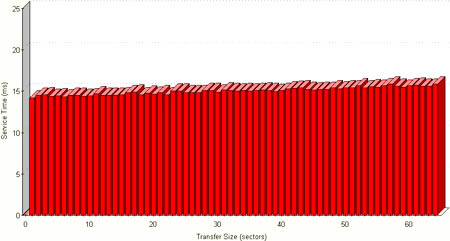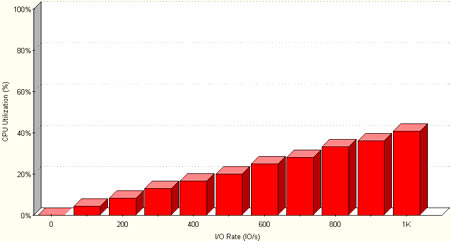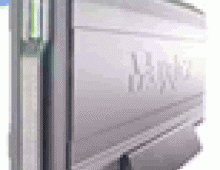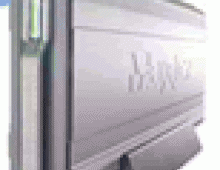Maxtor OneTouch II
5. Intel's IPEAK Read Tests
Review Pages
2. STEP BY STEP Installation
3. The program
4. Tests
5. Intel's IPEAK Read Tests
6. Conclusion
7. Detailed Specifications
- Intel's IPEAK Read Tests
- Read Service Time
The service time distribution is measured from a set of uniformly distributed
random single-sector disk accesses spanning the entire disk. As Intel explains,
the resultant distribution of service times is plotted as a probability
density vs service time. This curve represents the probability that a request
will be completed in a given amount of time. The service time distribution
is not cumulative.
The read service time measures the behavior of the storage device from
a set of uniformly distributed random single sector disk accesses spanning
the entire disk.
Well behaved devices must have no outliers in the service time distribution and the distribution should be narrow. Any outliers make the storage subsystem unsuitable for real time applications, such us multimedia.

-
Read Media Rate
The media transfer rate is evaluated in the same way as the cache read hit transfer rate. Rather than generating references that assure the accesses are cache hits, the references are generated to completely random disk locations in order to minimize the cache hit rate. The remaining portion of the evaluation is the same as for the cache read hit transfer rate evaluation. No overhead can be computed from this evaluation as the Y intercept is also a reflection of the average seek time and average latency.The graph presents the original measured data of service time vs transfer size in addition to the superimposed regression line. If the regression fits well, the transfer rate can readily be determined. The transfer rate should be disregarded if the regression does not fit well.

-
Read CPU Utilization
This is a test that measures the amount of CPU usage as the rate of read operations is increased.The resultant graph shows us how active the processor was during each sequence of the test.
Maxtor One Touch gives a good result with the USB 2.0 port.

-
Write Service Time
Again as Intel explains, write service time test gives a picture of the overall drive write access times and is very similar to the service time distribution for read accesses.By making the write requests back-to-back, typical write buffers are filled and the service time of the write requests as handled by a saturated write channel is observed.
The resultant distribution of service times is plotted as a probability density as a function of service time. This curve represents the probability that a request will be completed in a given amount of time. The service time distribution is not cumulative.
For well behaved I/O subsystems there should be no outliers in the service time distribution and the distribution should be narrow. Outliers in the distribution make the storage subsystem unsuitable for real-time applications, such as multimedia, where variations in service time are detrimental.

-
Write Seek Profile
This measurement is taken in the same way as for read operations. The disk transfers are all back-to-back in order to keep any write buffer full, thereby forcing physical disk operations. The resultant distribution of service times as a function of seek distance is computed and plotted as a contour view of a 3D surface. The effectiveness of write combining and other write optimization techniques can be ascertained from the graph.
In this test the leading edge of the access band must not fall away too quickly because this is an indication of poor seek performance. Maxtor shows good behavior in this test too.

Review Pages
2. STEP BY STEP Installation
3. The program
4. Tests
5. Intel's IPEAK Read Tests
6. Conclusion
7. Detailed Specifications




















